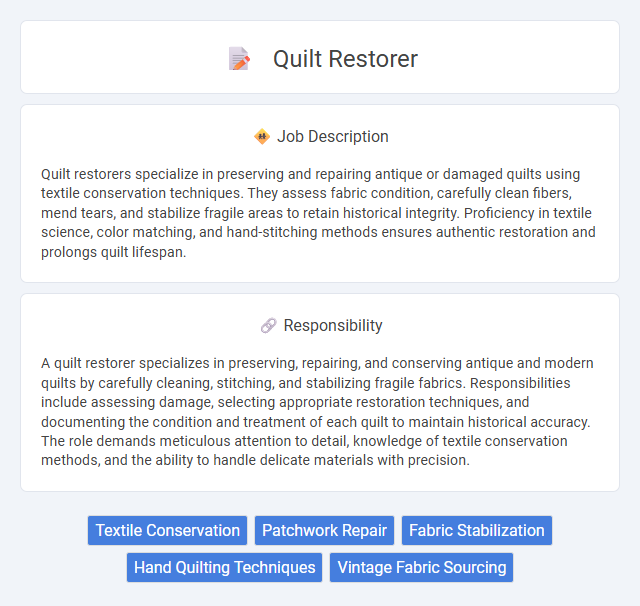
Quilt restorers specialize in preserving and repairing antique or damaged quilts using textile conservation techniques. They assess fabric condition, carefully clean fibers, mend tears, and stabilize fragile areas to retain historical integrity. Proficiency in textile science, color matching, and hand-stitching methods ensures authentic restoration and prolongs quilt lifespan.
People with a keen eye for detail and patience are likely to be well-suited for a quilt restorer job, as the work involves delicate handling and intricate repairs. Those who prefer hands-on, meticulous craftsmanship and have an interest in textile history may find this role particularly rewarding. Individuals with limited manual dexterity or low tolerance for repetitive, precise tasks might struggle to excel in this profession.
Qualification
Quilt restorers require expertise in textile conservation, with a focus on fabric identification, dye analysis, and stitching techniques. A background in art history, museum studies, or textile science is often essential, alongside hands-on experience in preservation methods. Proficiency in using specialized tools for delicate repairs and knowledge of environmental controls to prevent further deterioration are critical qualifications.
Responsibility
A quilt restorer specializes in preserving, repairing, and conserving antique and modern quilts by carefully cleaning, stitching, and stabilizing fragile fabrics. Responsibilities include assessing damage, selecting appropriate restoration techniques, and documenting the condition and treatment of each quilt to maintain historical accuracy. The role demands meticulous attention to detail, knowledge of textile conservation methods, and the ability to handle delicate materials with precision.
Benefit
Quilt restorers likely enhance the longevity and preserve the historical value of textiles, which could attract collectors and museums. They probably contribute to cultural heritage by maintaining intricate designs and traditional craftsmanship. This profession may offer a sense of accomplishment through meticulous restoration and the potential for specialized skill development.
Challenge
Quilt restoration likely involves the challenge of carefully preserving delicate fabrics while repairing damage to maintain historical accuracy and aesthetic appeal. Restorers probably need to balance the use of modern materials with traditional techniques to ensure the quilt's longevity without compromising its authenticity. The job may require meticulous attention to detail and patience to address issues such as fabric deterioration, fading, and threadbare areas.
Career Advancement
Quilt restorers with expertise in textile conservation and historical fabric preservation can advance to senior conservation specialist roles or museum curatorship positions. Mastery of advanced restoration techniques, knowledge of fabric science, and participation in professional conservation networks enhance career prospects. Opportunities for leadership in research projects and publishing in scholarly journals further establish professional authority and open pathways to academic or consultancy careers.
Key Terms
Textile Conservation
Quilt restorers specialize in textile conservation, expertly preserving and repairing historic and antique quilts to maintain their structural integrity and visual appeal. They utilize advanced techniques such as fabric stabilization, patching, and color matching while ensuring the use of archival materials that prevent further deterioration. Their work plays a critical role in safeguarding textile heritage for museums, collectors, and cultural institutions.
Patchwork Repair
Quilt restorers specializing in patchwork repair meticulously analyze fabric patterns and threads to seamlessly mend damaged sections, preserving the quilt's original design and historical value. Techniques include matching fabric types, colors, and stitching styles to ensure the repair integrates flawlessly with surrounding areas. Expertise in textile conservation and historical quilting methods is essential to maintain the authenticity and longevity of antique and heirloom quilts.
Fabric Stabilization
Fabric stabilization in quilt restoration involves reinforcing fragile or deteriorating textile fibers to prevent further damage and maintain the quilt's structural integrity. Techniques include gentle stitching, patching with compatible materials, and applying specialized adhesives that do not compromise the fabric's original texture or appearance. Expertise in historical fabric types and conservation-grade materials is essential for effective and authentic quilt preservation.
Hand Quilting Techniques
Hand quilting techniques require expert precision and a deep understanding of fabric preservation to restore quilts to their original beauty. Quilt restorers meticulously repair worn or damaged areas using traditional stitches, ensuring the integrity of both historical and contemporary textiles. Mastery in hand quilting allows restorers to maintain the quilt's authenticity while enhancing its durability for future generations.
Vintage Fabric Sourcing
Quilt restorers specializing in vintage fabric sourcing meticulously locate and acquire rare textiles to preserve historical authenticity in quilting projects. They evaluate fabric age, condition, and provenance to ensure compatibility with original quilt designs. Expertise in identifying period-specific materials enhances the restoration process and maintains the integrity of heirloom quilts.
 kuljobs.com
kuljobs.com